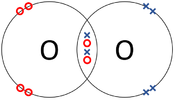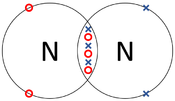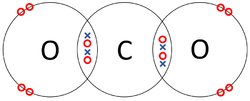Difference between revisions of "Covalent Bond"
(→About Covalent Bonds) |
|||
| Line 4: | Line 4: | ||
===About Covalent Bonds=== | ===About Covalent Bonds=== | ||
| − | : [[Atom]]s are more | + | : [[Atom]]s are more chemically stable when their [[Outer Shell|outer shell]] is full of [[electron]]s. One way [[atom]]s can have a full [[Outer Shell|outer shell]] is by sharing some [[electron]]s with other [[atom]]s, this is a '''covalent bond'''. |
: '''Covalent bonds''' happen between [[non-metal]] [[element]]s. | : '''Covalent bonds''' happen between [[non-metal]] [[element]]s. | ||
: '''Covalent bonds''' can be represented by a [[Dot and Cross Diagram]] to show how the [[electron]]s are shared between the [[Outer Shell|outer shells]] of different [[atom]]s. | : '''Covalent bonds''' can be represented by a [[Dot and Cross Diagram]] to show how the [[electron]]s are shared between the [[Outer Shell|outer shells]] of different [[atom]]s. | ||
Revision as of 17:50, 6 April 2019
Key Stage 4
Meaning
A covalent bond is a type of chemical bond in which atoms share electrons with one another.
About Covalent Bonds
- Atoms are more chemically stable when their outer shell is full of electrons. One way atoms can have a full outer shell is by sharing some electrons with other atoms, this is a covalent bond.
- Covalent bonds happen between non-metal elements.
- Covalent bonds can be represented by a Dot and Cross Diagram to show how the electrons are shared between the outer shells of different atoms.
Examples
| The two Oxygen atoms each share two of their electrons with one another. | The two Nitrogen atoms each share three of their electrons with one another. | Each Oxygen shares two of its electrons with the Carbon atom while the Carbon atom shares two electrons with each Oxygen atom. |


